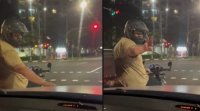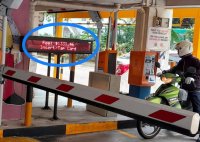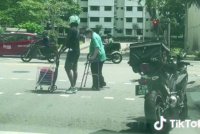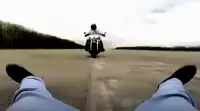.thumb.jpg.942d9c8d2090d78b3319f3cc3d3744e6.jpg)

All motorcyclists need to wear a motorcycle helmet, according to Singapore law. But understanding the “why” behind this law and how your motorcycle helmet works to protect you can significantly bolster your conviction to never ride without one.
First and foremost, without the structural protection of a car, the motorcycle helmet acts as a piece of armour for the rider against serious head injuries in the event of a crash or collision.
Because it’s such a crucial piece of protective equipment, choosing the right type and fit are incredibly important to ensure optimal protection.
In this article, we take an inside look into how motorbike helmets are designed to help mitigate damage in the event of a motorcycle accident, and what you need to pay attention to specifically.
It’s also essential to note that only PSB-approved helmets are allowed for use in Singapore, so pay special attention to the section below on how to ensure your motorcycle helmet meets the safety standards in Singapore!
The 5 Design Components of a Motorcycle Helmet
It’s clear that your motorcycle helmet protects your head from hard impact. But understanding what goes into motorcycle helmet design and how exactly each component works to protect you as a rider can deepen your respect for this utilitarian motorcycle gear piece.
1. Hit Zone
In a motorcycle accident, the rider is very often thrown off the bike. Your head landing on the hard ground can cause some serious damage.
And we’re not talking just outer injuries such as a cracked jaw or skull, but also traumatic brain injuries that occur inside, such as a coup-contrecoup injury (when the brain shifts violently inside the skull), or hematomas (bleeding) that can lead to serious brain damage, and even death.
You would think that the hugest hit zones would be the front and back of a helmet, but surprisingly - and important to note! - the most major impact zone is the chin and jaw area, followed by the forehead.
That is why full face helmets are always recommended, since they offer the highest level of protection.
Open face helmets are popular in Singapore because they are lighter, easier to put on and take off, and also cooler in the hot Singapore weather. But it’s also worthy to consider that the coolness you feel from the additional exposed area can also be a negative when you need protection the most.
If, in the event of a bike accident, you land face first on the road, you will be thankful you splurged a bit extra on a quality full face helmet instead of an open face helmet with just a padded chin strap.
2. Outer Shell
The outer shell of a bike helmet is obviously the first point of impact in an accident. That’s why it’s usually made of tough materials like polycarbonate or fiberglass, to prevent the penetration of sharp and high speed objects, as well as to withstand hard knocks and abrasions from daily use.
Most importantly, it helps distribute the force of impact over a larger area in a motorcycle accident. This prevents that intense, concentrated force from a collision from affecting a single point in your skull and head, and reduces the risk of skull fractures or localized injuries.
For this simple reason, you should always purchase a new motorcycle helmet, as you will never know what kind of damage or shock a second hand bike helmet might have undergone, thus significantly reducing its protective power.
3. Impact-Absorbing Liner
A tough outer shell may help against hard knocks, but just like an egg shell, it isn’t enough of a safety barrier between your head and the gravel road or pavement to keep you safe.
That’s why all motorcycle helmets are also designed with an impact-absorbing liner, typically made of expanded polystyrene (EPS) foam.
While the outer shell might bend and warp, the impact-absorbing liner compresses upon impact, cushioning your head, and effectively absorbing and dispersing the energy generated during a crash.
By absorbing some of the impact force, the helmet (and this liner in particular) minimizes the transfer of force to your head and brain in a great way. The dense inner layer also absorbs the shock and inertia created, when the helmet stops and the head continues moving from the impact. It’s sort of like a form of bubble wrap for your head, to prevent the contents from rattling too much!
Tip! Motorbike helmet manufacturers like Arai and Shoei recommend that motorcyclists should change their helmets every 5 years, even if the outer shell has no damage. This is because the foam inside the helmet might have degraded over time, and might not offer the same level of protection as a newly manufactured helmet.
4. Retention System
Needless to say, a motorcycle helmet can only protect you if it remains on your head in a crash.
Whether you’re wearing a full face helmet, or an open face helmet, the chin straps and fasteners are designed as part of this mechanism to keep your helmet on at all times, and not fly off in a high-impact situation.
So it’s crucial that your chin straps and fasteners are secure when you’re riding. When properly positioned, you should be able to put just two fingers between your chin and the strap, and not more than that.
An important point to note is that the only approved type of chin strap system allowed in Singapore is the double D-ring attachment system, so make sure that you are choosing a motorcycle helmet that meets Singapore’s safety standards.
The best protection is a bike helmet that fits you well and sits comfortably and snug on your head. There shouldn’t be any pressure points around the head, and the helmet should not be too loose or too tight.
5. Motorcycle Helmet Visor
For day to day use, your motorcycle helmet visor will help you manage wind resistance, dust, fog, and generally help keep your visibility optimal while on the roads. For extra safety, you can consider getting a motorcycle helmet with a built-in sun visor, or wear sunglasses while riding to reduce sun glare.
In the event of a crash, however, your helmet visor also serves as an essential shield to protect your face and eyes against flying debris, road particles, and other road hazards that can cause injury.
That is why your helmet visor or face shield is also designed to be an impact-resistant barrier against foreign object penetration, and also disperses the force of impact over a larger area, providing an additional layer of protection.
Check this out! Here’s a really interesting animation to explain how motorcycle helmets keep you safe, produced by American motorcycle helmet company SNELL. While their helmets are not currently approved for use in Singapore, the logic still stands!
The Importance of Singapore PSB Approved Helmets
As a responsible motorcyclist, you should always protect yourself while riding. In Singapore, you can be issued a penalty of $150 and 3 demerit points for failing to wear or not securely wearing a protective helmet. So, you should invest in a good bike helmet that meets all the crucial requirements and safety standards.
It’s also worth noting that in Singapore, motorbike riders caught wearing non-approved helmets could face severe penalties. The current law states that first-time offenders could be jailed for up to three months and/or fined up to S$500. If you’re caught a second time, you could be jailed for up to six months and/or fined up to S$1,000. And the Singapore government is even seeking to impose stiffer penalties on the importing or selling of non-approved helmets.
The safety requirements for motorcyclists’ protective helmets is based on the Singapore Standard 9 : 2014, which is listed by the PSB (Singapore’s Productivity and Standards Board), now renamed SPRING (Standards, Productivity and Innovation Board) Singapore.
Based on this, testing of motorcycle helmets involving various methods is conducted by a German testing, inspection and certification firm, known as TUV SUD.
This organization is responsible for testing the protective padding material, motorcycle shell structure integrity, helmet visor and the effectiveness of the retention system that keeps the helmet snug on the rider’s head.
If approved, a sticker with a blue tick and the words “Batch Inspected” is affixed at the back of the helmet to certify that it’s compliant with the safety standards and approved for use in Singapore.
(Source: channelnewsasia.com)
Important! ONLY PSB approved helmets with this approved sticker are legal for use in Singapore. Helmets that have passed international testing such as the ECE (Economic Commission for Europe), DOT (US Department of Transportation), and SNELL safety standards are not recognized in Singapore as approved helmets.
Never Ride Without a Helmet!
Knowing what you now know about how the various design components in your motorcycle helmet help keep you safe and alive, you should remember to never ride without a (/an approved) helmet!
However, it’s possible that bike accidents may still occur even if you take all the necessary precautions to avoid the fatal risk of skull damage and traumatic brain injury. If you are involved in a motorcycle accident resulting in serious injury – whether sustained by yourself or another road user – that’s when your motorcycle insurance is going to help. That’s why it is important to choose the right bike insurance cover and protection to cater for unexpected incidents.
Article Credits: DirectAsia
Join SingaporeBikes on Telegram for more of the latest news, special offers, reviews of motorcycles, and more!
- Read more...
-
- 0 comments
- 1,295 views
.png.f357c4bbda45b8d1f0301390a48a7ff4.png)















